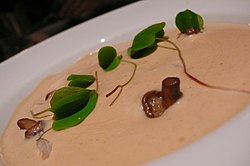Velouté sauce
This article needs additional citations for verification. (November 2009) |
 | |
| Type | Sauce |
|---|---|
| Place of origin | France |
| Main ingredients | Stock, roux |
A velouté sauce (French pronunciation: [vəluˈte]) is one of the five sauces of French cuisine that were designated the five "mother sauces" by Auguste Escoffier in the 19th century along with espagnole, tomato, béchamel and hollandaise, which was a simplification of the "Sauce Carême" list of Marie-Antoine Carême. The term velouté is from the French adjectival form of velour, meaning velvet.
In preparing a velouté sauce, a light stock (one in which the bones used have not been previously roasted), such as chicken or fish stock, is thickened with a blond roux. Thus the ingredients of a velouté are equal parts (by mass) of butter and flour to form the roux and a light chicken or fish stock, with some salt and pepper to season as needed. The sauce produced is commonly referred to by the type of stock used (e.g. chicken velouté).[1]
Derived sauces
Sauce velouté is often served on poultry or seafood dishes, and is used as the base for other sauces. Sauces derived from a velouté sauce include:
- Albufera sauce: Addition of meat glaze, or glace de viande.
- Allemande sauce: By adding a few drops of lemon juice, egg yolks, and cream
- Bercy: Shallots, white wine, lemon juice and parsley added to a fish velouté
- Poulette: Mushrooms finished with chopped parsley and lemon juice
- Aurore: Tomato purée
- Hungarian: Onion, paprika, white wine
- Sauce ravigote: The addition of a little lemon or white wine vinegar creates a lightly acidic velouté that is traditionally flavored with onions and shallots, and more recently with mustard.
- Sauce Vin Blanc: Sauce Vin Blanc has the addition of fish trim, egg yolks and butter and is typically served with fish.[2]
- Normande sauce: prepared with velouté or fish velouté, cream, butter and egg yolk as primary ingredients.[3][4] Some versions may use mushroom cooking liquid and oyster liquid or fish fumet added to fish velouté, finished with a liaison of egg yolks and cream
- Suprême sauce: By adding a reduction of mushroom liquor (produced in cooking) and cream to a chicken velouté
- Venetian sauce: Tarragon, shallots, chervil
- Wine sauce: such as white wine sauce and champagne sauce[5]
See also
References
- ^ Escoffier, Auguste; Adams, Charlotte (2000). The Escoffier Cookbook and Guide to the Fine Art of Cookery: For Connoisseurs, Chefs, Epicures Complete With 2973 Recipes (55 ed.). New York: Crown Publishers, Inc. pp. 19–21. ISBN 978-0-517-50662-2.
- ^ The Culinary Institute of America (2011). The Professional Chef (9th ed.). Hoboken, New Jersey: John Wiley & Sons. p. 278. ISBN 978-0-470-42135-2. OCLC 707248142.
- ^ Sinclair, Charles Gordon (1998). International Dictionary of Food and Cooking. Taylor & Francis. p. 373. ISBN 1579580572.
- ^ Pomiane, Edouard de (1994). French Cooking in Ten Minutes. Macmillan. pp. 40–41. ISBN 086547480X.
- ^ Berg, Ron. Northwoods Fish Cookery. U of Minnesota Press. pp. 218–219. ISBN 1452904782.
